
Tony Mansell tells the story of one man’s dream of owning a fairground organ and wonders how many fully understood the effort and skill that went into creating this amazing musical instrument.
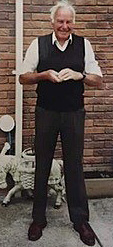 Bernard True
Bernard True
Bernard True was unsure if he was a Kentish Man or Man of Kent but whichever it was, we are grateful that he decided to make his home in Cornwall.
He was born in 1923 and moved to St Agnes after the Second World War. His parents had already settled here and when he left the Royal Navy he joined them and set up in business as a builder: B W True. Evidence of his outstanding joinery skill can till be seen around the village and in the superb dolls’ houses and other intricate pieces of work that he produced.
Bernard’s connection with the West of England Steam Engine Society began at its outset – in 1955; he was a founder member, the treasurer for many years and a Vice-President. In 1960 he purchased a steam roller which became his pride and joy and in 1982 he added a superb Garrett showman’s steam engine. His interest in old vehicles was not restricted to steam, however, as he also had three vintage lorries in his “fleet”. One was a 1937 three-ton Bedford which he restored and another was partially restored and now, in 2022, resides in the same stable as the fairground organ.
 Bernard and son, Martin, at a rally
Bernard and son, Martin, at a rally
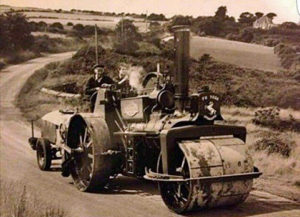 Bernard and son, Martin, en route
Bernard and son, Martin, en route
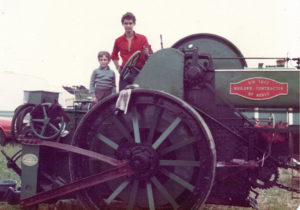 Martin True in charge of the steam roller with a young Andrew Mansell on board – early 1980s
Martin True in charge of the steam roller with a young Andrew Mansell on board – early 1980s
The steam rallies were a busy time for Bernard with his attention divided between his society duties and looking after his engines. Additionally, it was like a family outing and children Janet, Martin and Kathryn could often be seen riding on one or other of his steam engines. In fact, his enthusiasm rubbed off on Martin who became the main driver for many years.
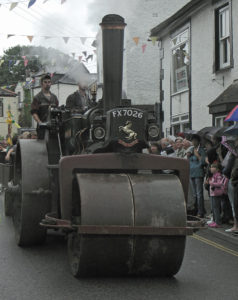 Bernard’s Aveling & Porter Steam Roller in the 2008 St Agnes Carnival
Bernard’s Aveling & Porter Steam Roller in the 2008 St Agnes Carnival
You would be excused for thinking that with two steam giants and three old lorries, Bernard had enough on his plate but whoever first penned the phrase, “Boys and their Toys”, could well have had him in mind because his thoughts were now directed to a new venture – a fairground organ.
It was in the early 1980s that Bernard began to look around to see if there were any organs for sale. In his words, “They were all a bit pricey”. That didn’t deter him, however, if anything it increased his interest, and he made up his mind to build one from scratch.
It seemed like an ambitious undertaking but, full of enthusiasm, he began his research. I cannot recall if plans for the structure were readily available or if he produced his own. It may have been the case that it was designed as it progressed but it was clear that he had a clear vision of what it would be like and with his usual determination, it was certain that it would get done.
The organ itself, that’s the musical instrument, was to be built by Dean Organ Builders of Bristol. In 1984 Bernard issued the necessary instructions for work to start. To satisfy the more technically minded this is Richard Dean’s description of the instrument:
“The organ plays the standard Dean 52 / 54 keyless scale which encompasses 8 bass, 12 accompaniment and 22 melody notes. Bernard wanted a more fairground sound so we included a flute register in place of the usual bourdon register on this model of organ. Bernard also had the keyframe enlarged and a counter melody fitted later to enable it to play 72 keyless music.”
I asked Bernard what it was going to cost but somehow he could never remember the actual figure. It was clear that he wanted to hide the cost, perhaps even to himself! Much later he said, “Anyway, I paid for it a bit at a time as it was being built and didn’t keep a record”.
While the organ was being made, Bernard began building its housing. Steve Beeney of Cardrew made the steel framework and this was mounted onto a trailer chassis. The showman’s engine had to give up its comfortable shed at Fairfields, just down from where the family later lived, in Goonvrea Road, so that work on the new project could continue whatever the weather.
The organ housing was made in sections in Bernard’s joinery workshop in Polbreen Lane (now, in 2022, the building has been demolished to make way for two dwellings). The sides comprised panels of tongue and grooved “v” jointed diagonal boarding which were carried to the shed and fixed to the steel frame. The roof comprised timber joists cut to a slight curve, covered with plywood and weatherproofed with sheet aluminium.
The housing completed, it was ready to receive the organ and Dean Organ Builders arrived with the instrument and transferred it from their delivery vehicle to its smart new home. It fitted perfectly. Was it ever in doubt?
Once in place, work began on creating the ornate façade. For this, drawings were available but knowing Bernard, it was almost certain that it had some originality attached to it. It was intricate and his considerable joinery expertise now came into play to produce a visual spectacle which complimented the musical instrument.
Finally, the front was painted, the extensive electric illuminations installed and the hand-carved wooden models put in place. To bring it all to life it was connected to a 5½kva generator to produce the electricity and the compressed air supply (a mains supply was used when available).
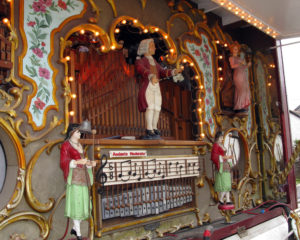
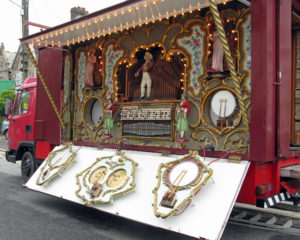 It must have been a tremendously exciting moment as the lights flashed for the first time and the sound of music filled the air.
It must have been a tremendously exciting moment as the lights flashed for the first time and the sound of music filled the air.
It only then remained for the shelving and other fitments to be built, the doors to be hung and the housing to be painted – in fairground maroon I am told.
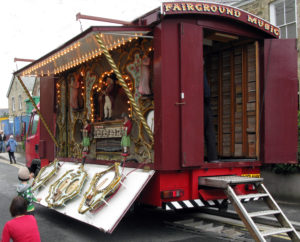
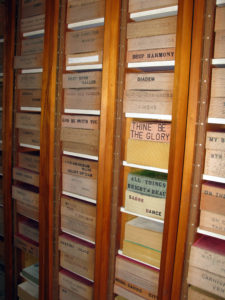
According to Bernard, “Two chaps from up country” made the music books; they were not cheap and he eventually purchased about fifty. They ranged from Light Cavalry to Colonel Bogey and from hymns to light polkas. As he said, “You have to have a variety to cope with the many requests”. A music book is made of linked pieces of thick cardboard which unfold as they are picked up by the organ’s mechanism. They pass across the keys and the punched holes operate specific notes and determine the tune that the organ produces. The card then pops out the other side and folds neatly back into book form.
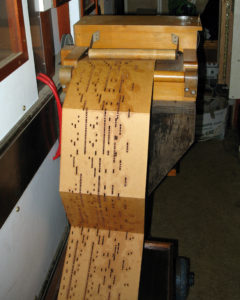
As I have already said, the original concept was an organ towed by a showman’s engine but Bernard decided that it had to be more easily transportable. The motive power would be diesel instead of steam and the organ began its public life being towed by a Land Rover.
It could so easily have ended there. On the way to an event, Bernard was driving down the steep hill into Mitchell when the trailer suddenly took on a life of its own. It began to swing from side to side. Gently at first but then to such an extent that it was pulling the rear of the Land Rover across the road. Visions of trailer, organ and Land Rover ending up in a mangled heap flashed through Bernard’s mind as he struggled to bring it under control. It seemed as though the organ had played its last note but as he gradually slowed, the trailer came under control.
Having survived that hairy moment it was clear that a new plan was needed. The organ and its housing was separated from its trailer and bolted onto the butt of a second-hand Leyland lorry, a good solution. All was now well but niggling in the back of Bernard’s mind was the thought that his new creation deserved better.
Then, one day, at the Royal Cornwall Show, he spotted it … a brand-new 7½ ton Leyland chassis and cab. Decision made, he registered it as J637 AHK and once again set about the transfer of the organ and housing to its new home. Then it really did look the part.
Much later, when everything was complete and in use, I asked Bernard why he had decided to have a fairground organ. I expected to hear about his passion for that type of music or his delight at the mechanics of such an instrument. What he said was, “I had a showman’s engine and someone said it would look good towing an organ”. However, the engine never towed the organ, at least not while he owned them, and in 1992 he sold the engine.

Bernard attended many events, often accompanied by Claude Tonkin of St Agnes. One year the lorry made a return visit to the Royal Cornwall Show – where it was originally purchased – but this time complete with its organ, as part of the entertainment. It was a regular feature at Stithians Show, the Dorset Steam Rally at Blandford, Devon Steam Rally and, of course, the West of England Steam Engine Society Rally initially held near St Agnes. It was a familiar sight to the people of so many towns and villages as it graced their events and helped their fund-raising efforts.
It was not cheap to run and apart from buying the music, the organ had to be regularly tuned, especially after changes in temperature. The reeds that replicate the sound of the trumpets and trombones had to be adjusted and those that did not have reeds, like the violins, had to be tuned at the top of the pipes. This was usually undertaken by the manufacturers but on at least one occasion our talented church organist and St Agnes Silver Band player, Clive Ellison, undertook it.
Always looking for a humorous story I asked Bernard to search his memory. Towing it with the Land Rover sprang to mind but I doubt that he saw the funny side at the time. Another instance was when he was at an event and an official looking chap asked him to start playing the organ right away. Ever eager to please, Bernard put on a rousing march. What he didn’t know was that someone had just begun to make a speech. It seems that the joker had disappeared and left Bernard to take the blame.
Bernard was unwell during his final years and just before his death, in 2012, he sold his beloved organ. Chris Vincent of Fraddon purchased it and added it to Bernard’s Showman’s Engine which he had bought about 20 years earlier.
So then, this is the story of Bernard True’s fairground organ. If you should come across it somewhere then stand and listen to enjoy the music by all means but also think of the work and skill required to make it, both by the organ builders and certainly by that hugely skilled craftsman, Bernard True.
Footnote:
Bernard’s interest in steam began with his steam roller which he sold to John Eastman in 2004. Now, in 2022, his son, Martin and grandson Joe, have continued the family interest in steam by purchasing a 1908 steam roller which they appropriately named Danny (after Bernard’s much-loved donkey).
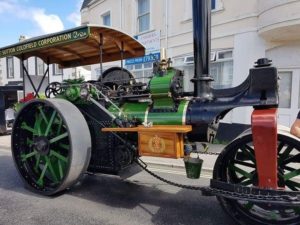 “Danny”
“Danny”
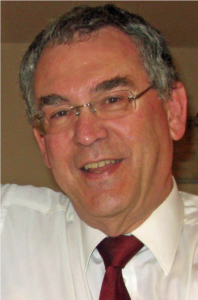
Tony Mansell is the author of several books on aspects of Cornish history. In 2011 he was made a Bardh Kernow (Cornish Bard) for his writing and research, taking the name of Skrifer Istori. He has a wide interest in Cornish history and is a researcher with the Cornish National Music Archive, a sub-editor with Cornish Story and was a close friend of Bernard.

Wonderful organ which I remember seeing at the RC Show – thank you for the story.
Enjoyed!
Ah yes, I remember him well. A kindly craftsman and pillar of St Agnes society, sharing his busy time with chat with anyone who showed interest in his hobbies. I do hope his creations are still in use and thrilling Cornishmen everywhere.
Thank you Tony for preserving memories of Bernard True for posterity.
John Wilson.
I am the Publications Editor for the Fair Organ Preservation Society. I also live in Cornwall, (Botallack), and knew Bernard well. I read your article with interest and wonder if you would allow me to reproduce it in our magazine, the Key Frame.
The next edition is almost ready for press, but with your permission, I would love to use it in the first edition of 2024, due to be out by mid March in time for our 2024 AGM.
I would of course give full credit to yourself and be more than happy to send you a copy of the magazine when it is done.
Incidentally, I remember well being approached by a delighted Mike Dean at the Great Dorset Steam Fair and being told that he had just taken an order for what was to be at that time the largest organ he had built. He wouldn’t say by whom uit it turned out to be Bernard.
Certainly Dave, no problem. Tony (tonymansell4@outlook.com)
Just saw this. Thank you so much, I am a bit desperate to fill the next edition, due out mid March, this should do the job nicely.
I will gladly send you a copy of the magazine if you would let me have an address to send it to. If you don’t want to post an address here, my phone number is 01736 788 928.
Thanks again, Dave S.
Hi Tony,
The Key Frame with your article re: Bernard true has been printed and is ready for mailing. I would like to send you a couple of copies but do not have an address Can I use the editors address in St Austell?